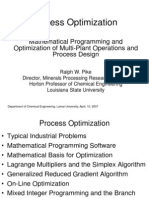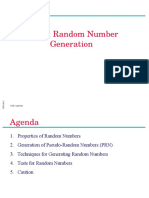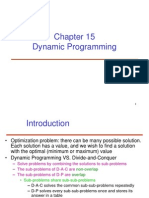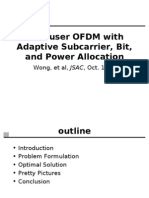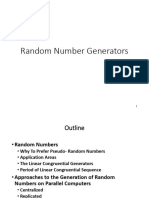Random Number Generation: Dr. John Mellor-Crummey
Random Number Generation: Dr. John Mellor-Crummey
Uploaded by
pyt000123Copyright:
Available Formats
Random Number Generation: Dr. John Mellor-Crummey
Random Number Generation: Dr. John Mellor-Crummey
Uploaded by
pyt000123Original Description:
Original Title
Copyright
Available Formats
Share this document
Did you find this document useful?
Is this content inappropriate?
Copyright:
Available Formats
Random Number Generation: Dr. John Mellor-Crummey
Random Number Generation: Dr. John Mellor-Crummey
Uploaded by
pyt000123Copyright:
Available Formats
Random Number Generation
Dr. John Mellor-Crummey
Department of Computer Science
Rice University
johnmc@cs.rice.edu
COMP 528 Lecture 21 5 April 2005
Topics for Today
Understand
Motivation
Desired properties of a good generator
Linear congruential generators
multiplicative and mixed
Tausworthe generators
Combined generators
Seed selection
Myths about random number generation
Whats used today: MATLAB, R, Linux
Why Random Number Generation?
Simulation must generate random values for variables in a
specified random distribution
examples: normal, exponential,
How? Two steps
random number generation: generate a sequence of uniform FP
random numbers in [0,1]
random variate generation: transform a uniform random
sequence to produce a sequence with the desired distribution
How Random Number Generators Work
Most commonly use recurrence relation
x n = f (x n"1, x n"2 ,...)
recurrence is a function of last 1 (or a few numbers), e.g.
!Example:
x n = (5x n"1 + 1) mod 16
For x0= 5, first 32 numbers are 10, 3, 0, 1, 6, 15, 12, 13, 2, 11, 8, 9,
14, 7, 4, 5, 10, 3, 0, 1, 6, 15, 12, 13, 2, 11, 8, 9, 14, 7, 4, 5
!xs are integers in [0,16]
dividing by 16, get random numbers in interval [0,1]
Properties of pseudo-random number sequences
from seed value, can determine entire sequence
they pass statistical tests for randomness
reproducibility (often desirable)
4
Random Number Sequences
Some generators do not repeat the initial part of a sequence
cycle length
tail
period
Desired Properties of a Good Generator
Efficiently computable
Period should be large
dont want random numbers in a simulation to recycle
Successive values should be
independent
uniformly distributed
Linear-Congruential Generators
1951: D.H. Lehmer found that residues of successive powers
of a number have good randomness
x n = a n mod m;
after computing x n"1, x n = ax n"1 mod m
multiplier
modulus
Lehmers generator: multiplicative LCG
Modern generalization: mixed LCG
x n = (ax n"1 + b) mod m
a,b,m > 0
Result: xn are integers in [0, m-1]
Popular because
analyzed easily
certain guarantees can be made about their properties
7
Properties of LCGs
Choice of a, b, m affects
period
autocorrelation
Observations about LCGs
period can never be more than m modulus m should be large
m = 2k yields efficient implementation by truncation
if b is non-zero, obtain period of m iff
m & b are relatively prime
every prime that is a factor of m is also a factor of a - 1
if m is a multiple of 4, a - 1 must be too
all of these conditions are met if
m = 2k, for some integer k
x n = (ax n"1 + b) mod
a = 4c + 1, for some integer c
b is an odd integer
Full-period generator = one with period m
not all are equally good
! adjacent elements = better
lower autocorrelation between
Example: Two Candidate LCGs
Which is better?
x n = ((2 34 + 1)x n"1 + 1) mod 2 35
x n = ((218 + 1)x n"1 + 1) mod 2 35
Both must be full period generators
m = 2k, for some integer k
a = 4c + 1, for some integer c
b is an odd integer
x n = (ax n"1 + b) mod m
Multiplicative LCGs
More efficient than mixed LCGs: no addition
Two classes: m = 2k, m 2k
10
Multiplicative LCG with m = 2k
n
x n = a mod 2
Most efficient LCG: mod = truncation
Not full-period: maximum possible period for m = 2k is 2k-2
only possible if multipler a = 8i3 and x0 is odd
!
consider
x n = 5x n"1 mod 2 5 (lcg_m2k_good)
x n = 7x n"1 mod 2 5 (lcg_m2k_bad)
If 2k-2 period suffices, may use multiplicative LCG for efficiency
11
Multiplicative LCG with m 2k
n
x n = a mod m, m " 2
Avoid small period of LCG when m = 2k: use prime modulus
Full period generator with proper choice of a
when a is primitive root of m
i.e. an mod m 1 for n = 1, 2, , m-2
Consider
x n = 3x n"1 mod 31 (lcg_mprime_good)
x n = 5x n"1 mod 31 (lcg_mprime_bad)
Note : 5 3 mod 31 = 125 mod 31 = 1
Observations
unlike mixed LCG, xn can never be 0 when m is prime
12
Examining Bits of a Multiplicative LCG
testgenerator(@r1,1,20)
n
decimal binary
--- ---------- ----------------1
25173 01100010 01010101
2
12345 00110000 00111001
3
54509 11010100 11101101
4
27825 01101100 10110001
!
5
55493 11011000 11000101
6
25449 01100011 01101001
7
13277 00110011 11011101
8
53857 11010010 01100001
9
64565 11111100 00110101
10
1945 00000111 10011001
11
6093 00010111 11001101
12
24849 01100001 00010001
13
48293 10111100 10100101
14
52425 11001100 11001001
15
61629 11110000 10111101
16
18625 01001000 11000001
17
2581 00001010 00010101
18
25337 01100010 11111001
19
11949 00101110 10101101
20
47473 10111001 01110001
x n = 25,173x n"1 mod 216
bit 1: always 1
bit 2: always 0
bit 3: cycle (10) of length 2
bit 4: cycle (0110) of length 4
In general:
kth bit follows cycle
of length 2k-2, k 2
Typical of multiplicative
LCG with modulus 2k
13
Examining Bits of a Mixed LCG
testgenerator(@r2,1,20)
n
decimal binary
--- ---------- ----------------1
39022 10011000 01101110
2
61087 11101110 10011111
3
20196 01001110 11100100
4
45005 10101111 11001101
!
5
3882 00001111 00101010
6
21259 01010011 00001011
7
65216 11111110 11000000
8
19417 01001011 11011001
9
30502 01110111 00100110
10
20919 01010001 10110111
11
26076 01100101 11011100
12
16421 01000000 00100101
13
44130 10101100 01100010
14
63139 11110110 10100011
15
32824 10000000 00111000
16
14513 00111000 10110001
17
51934 11001010 11011110
18
36303 10001101 11001111
19
35284 10001001 11010100
20
8573 00100001 01111101
x n = (25,173x n"1 + 13,849)mod 216
bit 1: cycle (10) of length 2
bit 2: cycle (1100) of length 4
bit 3: cycle (11110000) of length 8
In general:
kth bit follows cycle of length 2k
Typical of mixed LCG with
modulus 2k
14
LCG Cautions
Properties guaranteed only if
computations are exact: no roundoff
use integer arithmetic without overflow
Low-order bits not very random, high-order bits better
if one wants k bits && k < machine word length
better to choose high-order k bits than low-order k bits.
15
Tausworthe Generators
Significant interest in huge random numbers
cryptographic applications want many-bit random numbers
produce k-bit numbers by
produce random sequence of bits
chunk bit stream into k-bit quantities
1965: Tausworthe generator
bn = c q"1bn"1 # c q"2bn"2 # c q"3bn"3 # ... # c 0bn"q
c i and bi are binary variables
# is the xor operation (mod 2 addition)
uses last q bits of bit stream to compute next bit
autoregressive, order q: AR(q)
AR(q) generator maximum period = 2q - 1
16
Tausworthe Generator Notation
Characteristic polynomial notation
characteristic polynomial
x7 + x3 +1
bn +7 " bn +3 " bn = 0, n = 0,1,2,...
bn +7 = bn +3 " bn , n = 0,1,2,...
bn = bn#4 " bn#7 ,
n = 7,8,9,...
Most polynomials for Tausworthe generators are trinomials
Period depends on characteristic polynomial
if period = 2q - 1, characteristic polynomial is primitive polynomial
17
Implementing Tausworthe Generators
Linear feedback shift registers
x7 + x3 +1
bn +7 " bn +3 " bn = 0, n = 0,1,2,...
bn +7 = bn +3 " bn , n = 0,1,2,...
bn = bn#4 " bn#7 ,
bn
bn-1
bn-2
n = 7,8,9,...
bn-3
bn-4
bn-5
bn-6
bn-7
out
Disadvantage of Tausworthe generators
while sequence is good overall, local behavior may not be
known to perform negatively on runs up and down test
first-order serial correlation almost 0
suspected that some polynomials may give poor high-order corr.
18
Generating k-bit Random Numbers
k-bit random numbers xn from binary sequence bn
Generalized feedback shift register method (Lewis & Payne 73)
x n = 0. bn bn +sbn +2s ... bn +(k"1)s
s is carefully selected delay
s k: xn and xj have no bits in common for n j
!
s relatively
prime to 2q - 1: guarantees full period for xn
Advantage
xn can be generated very efficiently with wide-word shift and
exclusive or operations
Requires
storing an array of seed numbers
careful initialization of seed array
19
Extended Fibonacci Generators
Fibonacci sequence:
Fibonacci RNG:
Properties
x n = x n"1 + x n -2
x n = (x n"1 + x n -2 )mod m
not very good randomness
high serial correlation
Extended Fibonacci generator (Marsaglia 1983)
x n = (x!n"5 + x n -17 )mod2 k
state: ring buffer with 17 values
initialization
save integers in 17 values (not all integers even)
initialize j=16,k=4 cursors for buffer
generate
x = B[j] + B[k]
B[j] = x
j = j -1 mod 17; k = k -1 mod 17
return x
Properties
passes most statistical tests
period = 2k(217-1) (much longer than LCGs)
20
Some Combined Generators
Can combine 2 or more generators to produce a better one
Adding random numbers from 2 or more generators
if xn and yn are random sequences in [0,m-1], then
wn= (xn + yn) mod m
can be used as a random number
why do this?
can increase period and randomness if two generators have different periods
Exclusive-or random numbers from 2 or more generators
Santha & Vazirani (1984)
xor of 2 random n-bit streams generates a more random sequence
Shuffle
use sequence a to pick which recent element in sequence b to return
Marsaglia & Bray (1964)
keep 100 items of sequence b
use sequence a to select which to return next and replace
claim: better k distributivity than LFSR methods
problem: not easy to skip long sequence for multi-stream simulations
21
Seed Selection Issues
Wrong combination of seed and RNG can hurt
especially if RNG is flawed
e.g. seed might be RNG fixed point
Cases
one stream needed
if RNG has full period, then any seed as good as another
multiple streams needed
e.g. queue simulation requires
interarrival time stream
service time stream
requires special care!
22
Seed Selection Guidelines I
Dont use 0
multiplicative LCGs and Tausworthe generators would stick at 0
Avoid even values
seed should be odd for multiplicative LCG with m = 2k
for full period generators, all non-zero values equally good
Dont subdivide one stream
dont use a single stream for all random variables
might be a strong correlation between items in same stream
Use non-overlapping streams
each stream requires separate seed
dont use same seed for 2 or more streams!
if seeds are bad, streams will overlap and not be independent
right way: select seeds so streams dont overlap at all
example: need 3 streams of 20,000 numbers
pick u0 as seed for first stream
pick u20,000 as seed for second stream
pick u40,000 as seed for third stream
23
Seed Selection Guidelines II
Reuse seeds in successive replications
if simulation experiment is replicated several times
can use seeds from end of previous replication in next one
Dont use random seeds
simulation cant be reproduced
impossible to guarantee multiple streams wont overlap
24
Myths I
A complex set of operations leads to random results
complicated code random sequence of numbers that will pass
tests of uniformity and independence
A single test of goodness suffices
sequence 0, 1, , m-1
not random but passes chi-square test
will fail run test
use as many tests as possible
Pseudo-random numbers are unpredictable
e.g. can identify LCG parameters with a few numbers and predict
LCG unsuitable for cryptographic applications where
unpredictability is desired
Some seeds are better than others
e.g. odd vs. even, avoid particular seeds, etc.
x n = (9806x n"1 + 1)mod(217 "1)
37,911 is a fixed point!
may be true for some generators, but these should be avoided!
any non-zero seed should produce equally valid results
25
Myths II
Accurate implementation is not important
period and randomness are guaranteed only if formula is
implemented without overflow or truncation
overflows and truncations can
change the path of a generator
reduce the period
Bits of successive words are equally-randomly distributed
if an algorithm produces a k-bit wide number, randomness is
only guaranteed when all k bits are used
unless specified otherwise, assume any particular bit position
(or sequence thereof) will not be equally random
26
Whats Used Today: MATLAB
rand function
lagged Fibonacci generator
seed
cache of 32 floating point numbers
combined with a shift register random integer generator
core: j ^= (j<<13); j ^= (j>>17); j ^= (j<<5)
properties:
period: > 21492
fairly sure all FP numbers in [e/2,1-e/2] are generated
e = 2-52
27
Whats Used Today: R
Mersenne-Twister (Matsumoto and Nishimura,1998) [default]
twisted GFSR based on Mersenne primes
seed: 623-dimensional set of 32-bit integers + a cursor
period: 219937 - 1
equi-distribution in 623 consecutive dimensions (whole period)
[note: variant of MT for independent parallel streams exists too]
Knuth-TAOCP (Knuth, 1997)
GFSR using lagged Fibonacci sequences with subtraction
X[j] = (X[j-100] - X[j-37]) mod 230
seed: the set of the 100 last numbers + cyclic shift of buffer
period: about 2^129.
Knuth-TAOCP-2002
initialization of GFSR from seed was altered
28
Whats Used Today: R (continued)
Wichmann-Hill
seed: integer vector of length 3
seed[i] is in 1:(p[i] - 1)
p is the length 3 vector of primes, p = (30269, 30307, 30323)
cycle length: 6.9536e12 = prod(p-1)/4
reference: Applied Statistics (1984) 33, 123
Marsaglia-Multicarry multiply-with-carry RNG (Marsaglia)
seed: two integers, all values allowed
period: > 260
has passed all tests (according to Marsaglia)
Super-Duper (Marsaglia)
doesnt pass the MTUPLE test of the Diehard battery
period: about 4.6*10^18 for most initial seeds
seed: 2 integers (first: all values allowed; second: odd value).
default seeds are the Tausworthe and congruence long integers
29
Whats Used Today: Linux
random function
non-linear additive feedback-based generator
state: 8, 32, 64, 128, or 256 bytes
all bits considered random
rand function
bottom 12 bits go through cyclic pattern
higher-order bits more random
30
You might also like
- Number Theory Sheet SolutionDocument51 pagesNumber Theory Sheet Solutiongobinda prasad barmanNo ratings yet
- Control System Using MatlabDocument48 pagesControl System Using MatlabAnish BennyNo ratings yet
- Random Number GenerationDocument42 pagesRandom Number GenerationNikhil AggarwalNo ratings yet
- Generacion de Pseudo NumerosDocument19 pagesGeneracion de Pseudo Numerosnicoletto8No ratings yet
- Introduction: Efficient Algorithms For The Problem of Computing Fibonocci NumbersDocument23 pagesIntroduction: Efficient Algorithms For The Problem of Computing Fibonocci Numbersrey22mysterioNo ratings yet
- Random Number GenerationDocument42 pagesRandom Number GenerationsanniaNo ratings yet
- A Compressible " Poor Man ' S Navier Stokes " Discrete Dynamical SystemDocument12 pagesA Compressible " Poor Man ' S Navier Stokes " Discrete Dynamical SystemsamygamalNo ratings yet
- SQ Uniform (PPT) BestDocument19 pagesSQ Uniform (PPT) BestEr Aditya SinghNo ratings yet
- On UNIT-5Document45 pagesOn UNIT-5Neeraja BhukyaNo ratings yet
- OptimizationDocument117 pagesOptimizationKunal AnuragNo ratings yet
- DCTDocument32 pagesDCTAmardeep KumarNo ratings yet
- Reflectores de HouseholderDocument13 pagesReflectores de HouseholderPablo BurgosNo ratings yet
- Part 6: Random Number GenerationDocument42 pagesPart 6: Random Number GenerationLeiidy AceroNo ratings yet
- Dynamic Programming1Document38 pagesDynamic Programming1Mohammad Bilal MirzaNo ratings yet
- Gaussian Random Number Generator Using Boxmuller MethodDocument27 pagesGaussian Random Number Generator Using Boxmuller MethodAbhijeet Singh KatiyarNo ratings yet
- The Growth of Functions: Rosen 2.2Document36 pagesThe Growth of Functions: Rosen 2.2Luis LoredoNo ratings yet
- Multiuser OFDM With Adaptive Subcarrier, Bit, and Power AllocationDocument17 pagesMultiuser OFDM With Adaptive Subcarrier, Bit, and Power AllocationSimon SarwarNo ratings yet
- A Triggered Monostable Blocking Oscillator: Used in Legacy Channel RepeatersDocument12 pagesA Triggered Monostable Blocking Oscillator: Used in Legacy Channel RepeatersmcamhkNo ratings yet
- Random Number GeneratorDocument46 pagesRandom Number GeneratorNgNaNo ratings yet
- Introduction To Predictive LearningDocument101 pagesIntroduction To Predictive LearningVivek KumarNo ratings yet
- Srno4 - Conti....Document30 pagesSrno4 - Conti....Bharti VijNo ratings yet
- Computational Physics (PH-401) Lecture-20Document76 pagesComputational Physics (PH-401) Lecture-20Anuj MishraNo ratings yet
- Convol 3 D 16 BitDocument14 pagesConvol 3 D 16 BitmikimaricNo ratings yet
- System Planning 2013: Lecture 7: Optimization Appendix A ContentsDocument41 pagesSystem Planning 2013: Lecture 7: Optimization Appendix A ContentsShankaranarayanan GopalNo ratings yet
- Random Number GenerationDocument43 pagesRandom Number GenerationAnsh GanatraNo ratings yet
- The Sieve of EratosthenesDocument68 pagesThe Sieve of EratostheneslightNo ratings yet
- Nonlinear RegressionDocument11 pagesNonlinear RegressionmaracaverikNo ratings yet
- 5 Linear Programming-GraphicalDocument45 pages5 Linear Programming-GraphicalMuhammad EzzatNo ratings yet
- Optimal Control and Decision Making: EexamDocument18 pagesOptimal Control and Decision Making: EexamAshwin MahoneyNo ratings yet
- Mathematics For Microeconomics: Maximization of A Function of One VariableDocument35 pagesMathematics For Microeconomics: Maximization of A Function of One VariableYbnias GrijalvaNo ratings yet
- 2.007 Design and Manufacturing I: Mit OpencoursewareDocument46 pages2.007 Design and Manufacturing I: Mit OpencoursewareAmancio DohoNo ratings yet
- Sesi 3 Simulation BasicsDocument62 pagesSesi 3 Simulation BasicsRomario HeriyantoNo ratings yet
- 3.1 Basics of Pseudo-Random Numbers GeneratorsDocument10 pages3.1 Basics of Pseudo-Random Numbers GeneratorsEduardo LópezNo ratings yet
- 3.1 Basics of Pseudo-Random Numbers GeneratorsDocument10 pages3.1 Basics of Pseudo-Random Numbers GeneratorsMustafa RaadNo ratings yet
- Random-Number Generation: Discrete-Event System SimulationDocument32 pagesRandom-Number Generation: Discrete-Event System SimulationAreeba AshrafNo ratings yet
- Matlab Project Section B1Document50 pagesMatlab Project Section B1Biruk TadesseNo ratings yet
- Generation of Random Numbers and Random ObservationsDocument29 pagesGeneration of Random Numbers and Random ObservationsYoo LeeNo ratings yet
- Comparison of Multi-Carrier Modulation TechniquesDocument1 pageComparison of Multi-Carrier Modulation TechniquesGagandeep KaurNo ratings yet
- 05 Algorithm AnalysisDocument29 pages05 Algorithm AnalysisDavid TangNo ratings yet
- Towers of HanoiDocument21 pagesTowers of HanoihardnutNo ratings yet
- Optimization With Equality ConstraintsDocument34 pagesOptimization With Equality ConstraintsRaditya PratiknoNo ratings yet
- Lecture Slide StructsDocument54 pagesLecture Slide StructspatriquembeleonokokoNo ratings yet
- Introduction To Matlab SimulinkDocument45 pagesIntroduction To Matlab SimulinkSami KasawatNo ratings yet
- Queuing Theory and Traffic Analysis CS 552 Richard Martin Rutgers UniversityDocument149 pagesQueuing Theory and Traffic Analysis CS 552 Richard Martin Rutgers UniversitySenthil SoundarajanNo ratings yet
- Gr11 Mathematics Learner 1exponentsandsurdsDocument26 pagesGr11 Mathematics Learner 1exponentsandsurdslethabomolewa100No ratings yet
- 1 Asymptotic Notation - Algorithms (Series Lecture)Document35 pages1 Asymptotic Notation - Algorithms (Series Lecture)turjo987No ratings yet
- Quantum AiDocument65 pagesQuantum AiVikram Babu mamidishettiNo ratings yet
- Assignment 1 orDocument2 pagesAssignment 1 orPiyush VirmaniNo ratings yet
- Formulasheetalgebra 2 TrigDocument4 pagesFormulasheetalgebra 2 Trigapi-265200443No ratings yet
- The Mobile of The WorldDocument11 pagesThe Mobile of The World9al6oonNo ratings yet
- 25 Years of Cryptographic Hardware Design: City University of Istanbul & University of California Santa BarbaraDocument44 pages25 Years of Cryptographic Hardware Design: City University of Istanbul & University of California Santa BarbaraALEX SAGARNo ratings yet
- Algorithms - Chapter 4 Divide - ConquerDocument25 pagesAlgorithms - Chapter 4 Divide - ConquersiddiquentcNo ratings yet
- Canon's AlgorithmDocument11 pagesCanon's AlgorithmVenkatesan NNo ratings yet
- Opt 2 22052024Document3 pagesOpt 2 22052024shrinivasNo ratings yet
- Jay H Lee - MPC Lecture NotesDocument137 pagesJay H Lee - MPC Lecture NotesVnomiksNo ratings yet
- A Brief Introduction to MATLAB: Taken From the Book "MATLAB for Beginners: A Gentle Approach"From EverandA Brief Introduction to MATLAB: Taken From the Book "MATLAB for Beginners: A Gentle Approach"Rating: 2.5 out of 5 stars2.5/5 (2)
- Trigonometric Ratios to Transformations (Trigonometry) Mathematics E-Book For Public ExamsFrom EverandTrigonometric Ratios to Transformations (Trigonometry) Mathematics E-Book For Public ExamsRating: 5 out of 5 stars5/5 (1)
- Self Notes Crypto IseDocument20 pagesSelf Notes Crypto IseDAVIDSELVAKUMAR68No ratings yet
- Lots of Questions PDFDocument135 pagesLots of Questions PDFHrittik RoyNo ratings yet
- Modular ArithmeticDocument12 pagesModular ArithmeticJavadd KilamNo ratings yet
- QBASIC Notes: Algorithms & Psuedocode CLS, Rem, Locate, Print, EndDocument224 pagesQBASIC Notes: Algorithms & Psuedocode CLS, Rem, Locate, Print, EndAnkit DasNo ratings yet
- MAT246 ReflectionDocument4 pagesMAT246 ReflectionpablomlumsdenNo ratings yet
- Colected Papers, Vol. I, by Flroentin SmarandacheDocument229 pagesColected Papers, Vol. I, by Flroentin SmarandachemarinescuNo ratings yet
- EppDM5e 08 03Document46 pagesEppDM5e 08 03Maxi BradNo ratings yet
- 4 - Advance Encryption StandardDocument33 pages4 - Advance Encryption StandardDaneil RadcliffeNo ratings yet
- Mathematical SystemDocument87 pagesMathematical SystemLouis Borden SacroNo ratings yet
- Unit 2 - Operators and ExpressionsDocument31 pagesUnit 2 - Operators and ExpressionsAnurag GoelNo ratings yet
- Matm FinalsDocument6 pagesMatm FinalsAlvin MurilloNo ratings yet
- The Many Names Of: VOL. 75, NO. 2, APRIL 2002Document12 pagesThe Many Names Of: VOL. 75, NO. 2, APRIL 2002CJ JohnsonNo ratings yet
- Chinese Remainder's TheoremDocument5 pagesChinese Remainder's TheoremDivya MalooNo ratings yet
- Cs70 HomeworkDocument8 pagesCs70 Homeworkafeuettkk100% (1)
- Delphi Basics - Case CommandDocument2 pagesDelphi Basics - Case CommandnadutNo ratings yet
- Fast Scaling in The Residue Number SystemDocument5 pagesFast Scaling in The Residue Number SystemswarnasureshtrNo ratings yet
- Data Communication and Networking Fourth Edition by Behrouz A. ForouzanDocument51 pagesData Communication and Networking Fourth Edition by Behrouz A. ForouzanNick SarezNo ratings yet
- Q.1 Write A Program To Find Maximum Between Three Numbers.: CodeDocument89 pagesQ.1 Write A Program To Find Maximum Between Three Numbers.: CodeGeny ManyNo ratings yet
- MATH 240 NotesDocument51 pagesMATH 240 NotesSaeclusNo ratings yet
- Analytical No. Theory ComDocument251 pagesAnalytical No. Theory ComcohajNo ratings yet
- Quiz 2Document4 pagesQuiz 2Clash ClanNo ratings yet
- 8CT-CIS-Lab Updated Manual 2019Document44 pages8CT-CIS-Lab Updated Manual 2019SahilNo ratings yet
- David Burton Homework: 1 Problem 1Document6 pagesDavid Burton Homework: 1 Problem 1Abhinandan SahaNo ratings yet
- Kalpana Coaching Classess BE-SEM-VII-EXTC-DCE-Notes by Rohit Sinha Ph. Dadar-24330916 Thane-25440393 For Private Circulation Only SyllabusDocument50 pagesKalpana Coaching Classess BE-SEM-VII-EXTC-DCE-Notes by Rohit Sinha Ph. Dadar-24330916 Thane-25440393 For Private Circulation Only SyllabusDebasis DasNo ratings yet
- Orders, Primitive Roots, and Lifting The Exponent: Chirag SamantaroyDocument3 pagesOrders, Primitive Roots, and Lifting The Exponent: Chirag SamantaroyGregoriusNo ratings yet
- Australian Intermediate Mathematics Olympiad 2018: QuestionsDocument17 pagesAustralian Intermediate Mathematics Olympiad 2018: QuestionsAnggalol100% (2)
- CHAPTER 8 - The Mathematical SystemDocument28 pagesCHAPTER 8 - The Mathematical SystemSeymour ArcegaNo ratings yet
- Descrete Math MTH 401 PDFDocument11 pagesDescrete Math MTH 401 PDFAlisha Agarwal67% (3)
- MATH1081 Discrete Mathematics Tutorial Problems and Past Exam Papers With SolutionsDocument73 pagesMATH1081 Discrete Mathematics Tutorial Problems and Past Exam Papers With SolutionsShirley XuNo ratings yet









